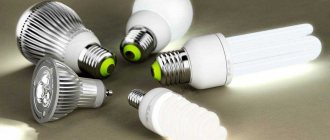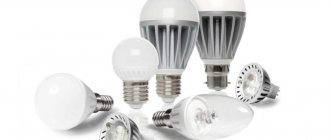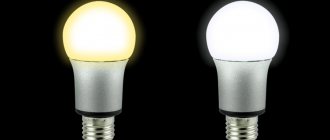Most often, you may encounter the question of why an LED lamp is blinking after repairing or replacing conventional incandescent lamps with energy-saving ones. There are 6 different ways to solve this problem. But to find out the reason for this strange behavior of the lamps, let’s first delve into the theory.
Here is one of the typical diagrams of an energy-saving lamp.
A voltage of 220V is supplied to the diode bridge. The result is a constant voltage of a certain ripple. To level out these ripples, capacitor C4 is used. It is this capacitor that is the culprit.
Switch backlight
The most important reason for blinking of switched-off LED and energy-saving light bulbs is the presence of backlight in the switch. When the switch is turned off, a small current still continues to flow through the backlight circuit, charging the filter capacitor. Having charged, the capacitor tries to start the lamp power circuit, but there is not enough “power” and it immediately discharges, and the light flashes briefly. Then it all repeats itself over and over again.
There are 6 common methods for eliminating the flickering of switched off energy-saving lamps:
- shunting with a resistor
- capacitor bypass
- connecting the backlight with a separate wire
- using a pass-through switch
- dismantling the backlight inside the switch
- connecting a conventional LED light bulb in parallel
Video description
Watch how to eliminate flickering of a lamp when the light is on in this video:
Most problems with flickering LEDs can be solved yourself. However, if you are not confident in your competence on this issue, it is better to ask a professional or a person who understands electrical engineering to diagnose and repair the equipment. Remember that the LED light bulb interacts with the electrical network, so it is important to follow safety precautions to protect against electric shock.
Shunting with a resistor
You can combat blinking by shunting the circuit with a certain resistance. To do this, take a resistor with a resistance of 1 mOhm and a power of 0.5 to 2 W.
For safety, it is better to insulate it with heat shrink.
The best connection location for the resistor is at the junction box. Connect it between the neutral and phase wires of the light bulb (in parallel with the energy-saving wire). It is especially convenient to connect this resistor through Wago clamps.
After this, your lamp will stop blinking.
If your junction box is hidden and there is no access to it (although this is already a violation), or there is no free space in it, then the resistor can be soldered directly to the phase and neutral wires of the chandelier. Then hide the ends in the terminal block.
The method has a big disadvantage.
The resistance will heat up, and if the power is selected incorrectly, it can even lead to a fire.
In addition, modern electronic meters in the apartment will take into account the energy consumption for heating the resistance, and you will end up paying not only for lighting, but also for this “modernization”.
Summing up
LED lighting is not slowing down in its popularity. But even with the prices for lighting devices based on them falling, they remain expensive. Why overpay if you can repair a light bulb or lamp yourself. You don't even need to purchase parts for this. You just don't need to throw away the ones that are broken. Then from two or three it will be possible to assemble one working one.
We hope the information presented in our article will help the reader save on purchasing lighting equipment. If you have any questions, you can ask them in the discussion below. And finally, we suggest watching a useful video on the topic:
Eliminate blinking LED lamp using a capacitor
If you don’t have a resistor, then instead you can use a capacitor with a capacity of 0.01 to 1 µF and a voltage with a double surge noise margin of 2*220=440V. But it is most reliable to take at least 630V.
When there is no capacitor for 630V, but there is one for 400V, then using a soldering iron you can assemble a circuit like this.
Here, one resistor serves to protect the capacitor from impulse noise, and the second to discharge the capacitor.
In an alternating current circuit, a capacitor is essentially a reactance, which is not taken into account by the electric meter and, unlike a resistor, the capacitor does not heat up.
Therefore, installing a capacitor is more preferable and safer. Install it in the same places as described above using resistance (distribution box, chandelier terminal block).
Where can I find such a capacitor? In order not to run around radio stores, you can simply disassemble the already burnt-out energy-saving lamp and pull it out or take it from a regular starter for fluorescent lamps.
True, there is one BUT. It is better to use paper or ceramic, because... Electrolytic may explode unsafely during power surges. So if you take it as a shunt, be sure to take it with a large voltage margin.
Why do cheap lamps flicker?
There are probably no people who have not heard that you should not buy cheap products from little-known manufacturers, as this is fraught with negative consequences of varying complexity.
This also happens in the case of LED lamps, which often begin to blink even immediately after purchase, which does not make the owners happy at all.
Flashing LED lights are quite common. However, in most cases they remain operational and, if the cause is eliminated, they will be able to function for years
But this mode of operation in most cases does not indicate the presence of a breakdown. That is, the lighting device is usually in good working order, but it is exposed to some unfavorable factors that interfere with its normal functioning.
And if they are eliminated, the flickering will stop, and there will be no relapses. But it is more practical to prevent such phenomena, and all that is needed for this is to purchase high-quality products from well-known manufacturers.
At the purchase stage, they will cost more, but high performance characteristics will ensure long-term operation. Moreover, without losing the best properties, and this costs a lot. Since cheap lighting devices allow you to save only on price.
And then a person is faced with their predisposition to various malfunctions and other negative consequences, including negative effects on health.
Modern LED lamps are always complex technological devices consisting of many components. Among them is a driver whose task is to stabilize the electric current.
And this is an important task, since high-quality and long-term work depends precisely on its characteristics, and not on voltage, as many believe.
Additionally, the driver is able to cope with various side factors that lead to flickering in the off/on position of the switch.
Every user should be aware that only cheap LED lamps made by various little-known manufacturers are prone to flickering. So you just shouldn't buy them.
But it is a mandatory part of the design of only high-quality and, therefore, expensive lamps. And in their affordable counterparts of Chinese and even domestic origin, to save money, this key element is always replaced with a cheaper power supply.
It is based on such design elements as a diode bridge equipped with a capacitive filter and a quenching capacitor. Which are able to provide high-quality lighting only when the characteristics of the electric current are ideal.
In this case, the work cycle looks like this:
- Initially, the alternating current passes through the diode bridge, where it is converted into the constant current needed for LED lamps, but with high ripple.
- To give the electric current stable characteristics, it is fed into a capacitive filter. And from there to a damping capacitor, which finally smoothes out the ripple.
- Current with the required characteristics goes to the lighting devices, allowing them to perform their duties properly.
But with non-ideal electric current parameters, the power supply with its cheap components is not able to cope with ripple and its rectification, which ultimately causes blinking.
Either one lamp or a whole separate group can blink. However, the reasons for this phenomenon are the same. And they should be eliminated promptly. Otherwise, the life of the lighting fixtures will be exhausted in a short time.
In addition, signs of such a malfunction can appear both in off and on states.
And the features of each type of emergency work should be known, as this will help eliminate the defect. Moreover, quickly and often without any serious costs.
Separate neutral wire
If your switch is located in the same block as the socket or the neutral wire is also connected to the switch, then the backlight can be rigidly connected to the phase and neutral. It will be on constantly, but the light will no longer blink. The method involves laying additional wires and is not very convenient.
Pass-through switch
You can also use a pass-through switch instead of a regular one. In this case, the light will be on in one position, and the backlight in the second. The light will also not blink.
This is achieved by direct supply of only neutral conductors to the lamp in the off position.
And no amount of interference will make it light up. True, here you also need to connect the neutral conductor to the switch. But this method allows you to get rid of blinking, even when the backlight is not the cause! (discussed below).
If you are not too bothered by the additional costs associated with purchasing a pass-through switch, and you do not want to go into the weeds of choosing suitable resistors and capacitors, then this method is the most optimal.
Reasons for LED blinking when the light is on
Insufficient mains voltage
This is the most common situation in which the LED lamp blinks when turned on. In areas outside the city, and even in some urban areas, the load on the supply network typically does not exceed 200V. This leads to a lack of voltage when certain electrical appliances are turned on, including flickering when the LED lamp is turned on. Under such a load, only a light bulb with a driver can function normally. You can also buy a light bulb that operates at a load of 180 to 250V.
Blinking may also occur due to the use of a dimmer, a device for adjusting the brightness of the light supplied by the lamp. However, the light bulb itself may not be designed to work with different brightness levels. This model starts blinking immediately upon connection if the dimmer is not turned on at full power. If the LED lamp is blinking, you can simply turn the dimmer to maximum - then there will be no flickering, but the dimmer will then only work in this position.
LED lamp with dimmer Source dekoriko.ru
If there are constant interruptions in the supply of a stable load in the house, the solution is to purchase a voltage stabilizer. It will eliminate flickering of LED lamps and protect them from rapid failure.
There is also a separate category of lighting devices that operate at 12V load. To operate in the house, they are connected to a step-down device, which is connected to the main network. But such a light may also blink, which usually indicates low power in the power supply module of the device. Typically the problem occurs when installing halogen bulbs instead of LEDs in spotlights.
Poor LED quality
Sometimes you can think for a long time and check for what technical reasons and why the LED lamp blinks when it is turned on, but the reason turns out to be simple - low quality of the product.
If the light bulb blinks at certain intervals, the flickering may not even be noticeable to humans. The cause of the problem is the poor quality of the LED power module, which cannot correctly handle the rectified load.
Design of a standard LED lamp Source nifigas.ru
Connecting a simple light bulb
And when the chandelier has several horns, instead of one energy-saving light bulb, you can place an incandescent lamp in parallel. The flashing should also stop. The method only works if there are several cartridges in one lamp and is probably the least expensive.
There are pros and cons here. The downside is that you lose the benefits of energy savings, for which you most likely switched to energy-saving devices. Plus, the lighting becomes more pleasing to the eye. Some jewelry workshops use just this kind of light.
Conclusions.
Thus, almost any flicker can be eliminated. Although it is more practical to prevent its occurrence in advance. An important factor in this case is the choice of high-quality light sources and control equipment. In this case, the possibility of humming and flashing is minimal.
- Related Posts
- LED lamps g9: device, principle of operation, scope of application, popular models
- DRI lamp (metal halide)
- LED strip soldering or connectors, connection methods, tools and materials
Blinks even without a backlit switch
What to do if your switch is not backlit, but the lamp still blinks? When the switch is turned off, the long power wire of the lamp can act as a kind of antenna. And if many parallel energized wires are laid next to it in one groove, then in the disconnected wire of the light bulb, they will begin to induce their electric field.
As a result, a potential is formed that can charge the filter capacitor in the fluorescent lamp power circuit.
What to do about it? You can still bypass the lamp with a relatively small resistance, a capacitor, or use the methods described above.
A little about the design and principle of operation of LED lamps
At the beginning of its appearance, the “LED” was called a “smart lamp”. The product is economical, durable and environmentally friendly. The light bulb is an autonomous mechanism that regulates the lighting process itself.
The LED lamp consists of:
- base;
- polymer base of the base part;
- drivers;
- radiator;
- aluminum printed circuit board;
- chips;
- diffuser.
The base part of the light bulb is screwed into the lamp socket. The base is made of brass with a nickel coating, which ensures contact and protection against corrosion. In the base part there is a polymer base that protects the case from electrical penetration.











